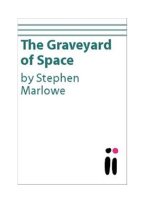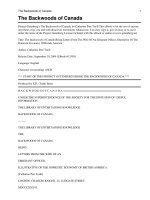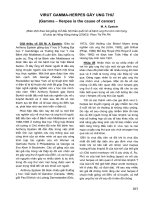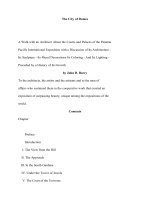DEVELOPMENT COMMUNICATION SOURCEBOOK: Broadening the Boundaries of Communication potx
Bạn đang xem bản rút gọn của tài liệu. Xem và tải ngay bản đầy đủ của tài liệu tại đây (2.16 MB, 266 trang )
DEVELOPMENT
COMMUNICATION
SOURCEBOOK
Broadening the Boundaries
of Communication
Paolo Mefalopulos
Development
Communication
SourcebookDevelopment
Communication
Sourcebook
Broadening the Boundaries
of Communication
Paolo Mefalopulos
© 2008 The International Bank for Reconstruction and Development/The World Bank
1818 H Street NW
Washington DC 20433
Telephone: 202-473-1000
Internet: www.worldbank.org
E-mail:
All rights reserved
1 2 3 4 11 10 09 08
This volume is a product of the staff of the International Bank for Reconstruction and Develop-
ment / The World Bank. The findings, interpretations, and conclusions expressed in this volume
do not necessarily reflect the views of the Executive Directors of The World Bank or the govern-
ments they represent.
The World Bank does not guarantee the accuracy of the data included in this work. The
boundaries, colors, denominations, and other information shown on any map in this work do
not imply any judgement on the part of The World Bank concerning the legal status of any ter-
ritory or the endorsement or acceptance of such boundaries.
Rights and Permissions
The material in this publication is copyrighted. Copying and/or transmitting portions or all of
this work without permission may be a violation of applicable law. The International Bank for
Reconstruction and Development / The World Bank encourages dissemination of its work and
will normally grant permission to reproduce portions of the work promptly.
For permission to photocopy or reprint any part of this work, please send a request with com-
plete information to the Copyright Clearance Center Inc., 222 Rosewood Drive, Danvers, MA
01923, USA; telephone: 978-750-8400; fax: 978-750-4470; Internet: www.copyright.com.
All other queries on rights and licenses, including subsidiary rights, should be addressed to the
Office of the Publisher, The World Bank, 1818 H Street NW, Washington, DC 20433, USA; fax:
202-522-2422; e-mail:
ISBN: 978-0-8213-7522-8
eISBN: 978-0-8213-7523-5
DOI: 10.1596/978-0-8213-7522-8
Library of Congress Cataloging-in-Publication Data
Mefalopulos, Paolo.
Development communication sourcebook : broadening the boundaries of communication/
Paolo Mefalopulos.
p. cm.
Includes bibliographical references and index.
ISBN 978-0-8213-7522-8 (print) ISBN 978-0-8213-7523-5 (electronic)
1. Communication in economic development. I. World Bank. II. Title.
HD76.M44 2008
338.9001'4 dc22
2008016703
Cover: Patricia Hord Graphik Design
Contents
Preface xi
Abbreviations xv
Introduction xvii
Module 1. The Value-Added of Development Communication 1
1.1 What Communication? 3
1.2 The Value-Added of Development Communication in
Programs and Projects 8
1.3 Ten Key Issues about (Development) Communication 18
1.4 Understanding the Scope and Uses of
Development Communication 21
1.5. The Operational Framework of the Development
Communication Division 28
Summary of Main Points in Module 1 32
Notes 33
References 34
Module 2. Reflections on the Theory and Practice of
Development Communication 37
2.1 Setting Common Ground on Key Terminology 39
2.2 Development and Communication: An Overview 43
2.3 A Different Take on Development Communication
Applications 64
v
2.4 Combining Theory with Practice: The Multitrack
Model 68
Summary of Main Points in Module 2 74
Notes 75
References 76
Module 3. Development Communication Methodological Framework
and Applications 81
Principles and Methodology Fundamentals of the
Four-Phase Framework 83
3.1 Phase 1—Communication-Based Assessment 94
Communication-Based Assessment Toolbox 105
3.2 Phase 2—Communication Strategy Design 111
Communication Strategy Design Toolbox 126
3.3 Phase 3—Implementing the Communication
Program 129
Communication Toolbox for Implementation 134
3.4 Phase 4—Communication for Monitoring
and Evaluation 135
Communication Toolbox for Monitoring and Evaluation 147
Summary of Main Points in Module 3 149
Notes 150
References 151
Module 4. Development Communication Services and Operations
at the World Bank 153
Introduction: Development Communication Services
and Experiences at the World Bank 155
Part I: DevComm Scope and Service Lines 157
4.1 The Development Communication Division Scope
and Service Lines 157
Contents
vi
Notes 171
Part II: The World of Practice: Some Experiences 172
4.2. Development Communication to Fight Poverty
through Poverty Reduction Strategy Papers 172
Notes 179
4.3. Community Radio: Supporting Local Voices through
the Airwaves 180
Notes 193
4.4 Disability and Development: What Role
for Communication? 195
Notes 202
4.5 How a Multilateral Institution Builds Capacity in
Strategic Communication 204
Notes 213
4.6 Assessing the Impact of Development
Communication 214
Notes 223
Summary of Main Points in Module 4 226
Appendix The Rome Consensus 227
Glossary 231
Index 235
Boxes
1.1 Getting Results through Interpersonal
Communication Methods 10
1.2 A Typology of Participation in Development Initiatives 11
1.3 Comparing and Contrasting CNA and CBA 15
1.4 When a Perfectly Appropriate Technical Solution
Does Not Make Much Sense 16
Contents
vii
2.1 The Importance of the First Mile 62
2.2 A Different Use of Video 64
2.3 Communication to Inform and Change Behavior 69
2.4 The World Congress on Communication
for Development (WCCD) 70
3.1 The Power of Participatory Communication for
Social Change 96
3.2 When Perceptions Diverge 98
3.3 Addressing the Correct Communication Entry Point
or Level 100
3.4 A Communication Road Map to Change 133
4.1 Evaluating the Performance of Communication in
Public Sector Reforms 169
4.2 Community Radio in Community-Driven Development
Projects: Kenya, Ghana, and Sri Lanka 188
4.3 Community Radio and Women’s Participation:
Timor-Leste 190
4.4 Community Radio in Disaster Management:
Aceh, Indonesia 191
Figures
1.1 Windows of Perception in an Agricultural Project 12
1.2 Mice Reconstructing an Image of a Cow 17
1.3 DevComm Methodological Framework 29
2.1 The Multitrack Communication Model 73
3.1 The Process Pyramid 84
3.2 DevComm Methodological Framework 88
3.3 Windows of Perceptions in a Software Innovation 99
3.4 Using Communication Materials to Facilitate Dialog 122
3.5 The Communication Program Design and
Implementation Process 132
Contents
viii
4.1 DevComm Portfolio in FY04 and FY06 156
4.2 Basic Phases of a Communication Program 166
4.3 Links between Communication Program and
Project Cycle 170
4.4 DevComm Portfolio by Sector in March 2006 215
Tables
1.1 Common Types of Communication in
Development Organizations 5
1.2 Basic Features of Communication Modes 24
2.1 Basic Differences in the Two Communication Modes 59
3.1 Levels of Participation and Communication 91
3.2 The Johari Window 95
3.3 CBA Main Steps 104
3.4 Defining the Objective 114
3.5 Main Steps of Communication Strategy Design 117
3.6 The Communication Action Plan 129
4.1 Steps in Developing a Communication Plan for PRSPs 175
Contents
ix
The main reason for writing this book was not simply to gather, organize, and dis-
seminate knowledge on development communication. Rather,it was to make the case
for its systematic adoption in development policies and practices. My long experience
in the field made me realize that the media-centric conception of communication
was not making a significant difference in people’s lives. Too often the most impor-
tant missing element in development programs was genuine (two-way) communica-
tion between the decision makers, the experts, and the so-called beneficiaries.
Media, no matter how technologically advanced; messages, no matter how skillful-
ly packaged; and information, no matter how relevant, are not enough to bring about
meaningful and sustainable results. These results can only be achieved if the people
involved (stakeholders) are part of the process leading to change. This realization shift-
ed my professional focus from media to people, from the products to the process.
My frustration at the frequent misuse of the term “communication for develop-
ment” has been a major impetus in writing this book. The Sourcebook intends to
make clear the seemingly straightforward distinction between “communication
about development operations and results” and “communication for development
operations and results.” In the first case, communication is used to inform audi-
ences about development initiatives, activities, and results. It is about transmitting
information and messages. In the second case, communication is applied to engage
stakeholders, assess the situation, and devise effective strategies leading to better
and more sustainable development initiatives. It is more than transmitting informa-
tion; it is about using communication to generate new knowledge and consensus in
order to facilitate change. Both are important and require a different body of knowl-
edge and different set of skills.
The preparation of the Development Communication Sourcebook has been a
long dialectical process, where my knowledge and many of my ideas have been
challenged by colleagues and by frequent reality checks. Trying to provide a brief
but accurate historical overview of this interdisciplinary field, accounting for its
most recent conceptual and practical developments, and combining this knowledge
with the vast pool of experiences in the World Bank and in many other organiza-
tions, has proved to be a highly demanding task. The end product is a publication
xi
that can be used as a primer, not only by those in the communication field, but also
by development managers, practitioners, and students interested in knowing more
about development communication.
In an institution such as the World Bank, which is dominated by economists, a
soft science such as communication has often been relegated to the back seat. This
has happened despite the fact that past approaches, driven by economic theories,
have not always produced significant results and despite the fact that lack of com-
munication has often been identified as a major cause of project failure.
This Sourcebook illustrates how the emerging paradigm in development commu-
nication, focused on participation and two-way communication, constitutes a neces-
sary element if we are to avoid the mistakes of the past. It makes the case about the
importance of incorporating communication practices into the policies and practices
of development. It intends also to offer a broader conception of communication that
would take into account other purposes and functions than the usual ones. Commu-
nication is not only about raising awareness, informing, persuading, or changing
behavior. It is also about listening, exploring, understanding, empowering, and build-
ing consensus for change. This should resonate loud and clear for the reader.
Two-way communication, used to understand, assess, explore, and facilitate
decision making related to change, combined with the effective use of one-way
communication approaches, has been proven to significantly enhance results and
the sustainability of development initiatives. This Sourcebook is intended to pro-
vide a small contribution in further promoting the understanding and subsequent
adoption of such practices, in any sector of intervention.
To sum up, these are the two key messages of this publication: (1) two-way com-
munication, when used from the onset of a development initiative, is not only a
useful but also a necessary ingredient to enhance development initiatives and avoid
the failures of the past, and (2) two-way communication should be applied profes-
sionally by specialists familiar with the rich body of knowledge and the diverse
range of methods, techniques, and tools of development communication.
There are many individuals who should be acknowledged and thanked for having
contributed to the production of the Sourcebook. The peer reviewers who went
through the final draft of the manuscript played a major role. With their knowledge
and experiences they raised critical issues and gave constructive suggestions that
helped improve and refine the final version of the Sourcebook. They include Grazia
Atanasio, Communications Officer, World Bank; Kreszentia M. Duer, Program Man-
ager, New Bank Practices in Civic Engagement, Empowerment, and Respect for
Diversity, World Bank Institute; Professor Thomas Jacobson, Sr., Associate Dean for
Academic Affairs, Temple University; Sumir Lal, Head, Internal Communications,
World Bank; Regina Monticone, Chief, Development Partnerships, Department of
Communications and Public Information, International Labour Organization;
Rafael Obregon, Associate Professor, School of Media Arts and Studies, and Director
Preface
xii
of the Communication and Development Studies Program at Ohio University; and
Adesinaola Michael Odugbemi, Head of the Communication for Governance and
Accountability Program, World Bank.
Other World Bank colleagues should also be acknowledged for their comments
on specific parts of the Sourcebook. They include Natalia Kirpikova, Kosta Kostadi-
nova, Leonardo Mazzei, and Irina Oleinik. A number of other individuals have pro-
vided valuable insights, sometimes even unknowingly, and assistance that made the
completion of this process easier. Among them are Mario Acunzo, Mario Bravo,
Daniele Calabrese, Nawsheen Elaheebocus, Eliana Esposito, Manuela Faria, Lucia
Grenna, Kafu Kofi Tsikata, Anjali Manglik, Antonietta Poduie, Emanuele Santi,
Mohamed Sidie Sheriff, Obadiah Tohomdet, and Stephanos Tsekos. It would be
impossible to list all those who contributed in one way or another to this project, but
a sincere note of appreciation is extended to all of them.
Preface
xiii
AFD French Development Agency
AfDB African Development Bank
AKAB awareness, knowledge, attitudes, and behaviors (or practices)
ALRMP Arid Lands Resource Management Project
AMARC World Association of Community Radio Broadcasters
ARRnet Aceh Reconstruction Radio Network
ASTD American Society for Training and Development
BCC behavior change communication
CAS country analysis strategy
CBA communication-based assessment
CDD community-driven development
CDD/R Departmental Development Committees
CEERD Civic Engagement, Empowerment, and Respect for Diversity
CEP Community Empowerment and Local Governance Project
(Timor-Leste)
CFSC Communication for Social Change
CIDA Canadian International Development Agency
CNA communication needs assessment
CommGAP Communication for Governance and Accountability Program
CPR country portfolio review
CRPD Convention on the Rights of Persons with Disabilities
DAC Development Assistance Committee (of OECD)
DevComm Development Communication Division of the World Bank
DevComm-SDO Sustainable Development in Operations Unit of DevComm
DFID Department for International Development (United Kingdom)
DPOs disabled persons organizations
EXT External Affairs (World Bank vice presidency)
xv
GTZ German Agency for Technical Cooperation
HNP health, nutrition, and population projects
IADB Inter-American Development Bank
ICT information and communication technologies
IEC information, education, and communication
ISN Information Solutions Network
JRKY Jaringan Radio Komunitas Yogyakarta (Indonesia)
LFA logical framework analysis
MDGs Millennium Development Goals
M&E monitoring and evaluation framework
NECDP Nutrition and Early Child Development Project
NGO nongovernmental organization
NOPS needs, opportunities, problems, solutions
NWICO New World Information and Communication Order
OECD Organisation for Economic Co-operation and Development
PAD project appraisal documents
PAR participatory action research
PRA participatory rural appraisal
PRCA participatory rural communication appraisal
PRS poverty reduction strategy
PRSP Poverty Reduction Strategy Paper
RRA rapid rural appraisal
SAF situation analysis framework
SIDA Swedish International Development Cooperation Agency
SMART specific, measurable, achievable, realistic, and timely
SMCR Sender-Message-Channel-Receiver
UNDP United Nations Development Programme
UNESCO United Nations Educational, Scientific, and Cultural
Organization
USAID United States Agency for International Development
WCCD World Congress on Communication for Development
WOPs Windows of Perceptions
WSIS World Summit on the Information Society
ZOPP objective-oriented project planning
Abbreviations
xvi
Introduction
Why a Sourcebook on Development Communication?
The Development Communication Sourcebook aims to provide a clear understand-
ing of the field of development communication and its more recent trends. It illus-
trates why this field is important and how its methods and tools can be applied
effectively to enhance long-term results. The Sourcebook addresses everyone who
has an interest in the success and sustainability of development initiatives, from
communication practitioners to managers.
Two factors guided the rationale for writing the Sourcebook. First, despite the
growing recognition enjoyed by the discipline of development communication, its
nature and full range of functions are still not fully known to many decision mak-
ers and development managers who tend to identify this field merely with the art
of disseminating information effectively. Second, because of the recent shift in the
development paradigm (that is, from one-way to two-way communication) and
the related changes in the field of development communication, many communi-
cation practitioners are not entirely aware of the discipline’s rich theoretical body
of knowledge and the wealth of its practical applications—which are growing in
relevance for the development context.
The Sourcebook is divided into modules that can be read sequentially, to gain a
comprehensive overview, or individually, to allow readers to select specific modules
for their professional interest or for training purposes. The challenge is to engage
readers’ different interests while presenting the richness of development communi-
cation, which has broadened beyond diffusion to incorporate the more horizontal,
dialog-based approaches needed to ensure mutual understanding and to investigate
issues before other forms of communication take place.
The Evolution of Development Communication
The initial stages of development communication were characterized by the use of
mass media that considered people as audiences ready to be influenced by the mes-
xvii
sages they received. That communication perspective is rooted in the basic Sender-
Message-Channel-Receiver (SMCR) model, which has been widely criticized. This
model envisions a sender transmitting a message through the appropriate channel
to a receiver (or group of receivers). If done properly, the dissemination of infor-
mation was viewed as capable of achieving the intended behavior change. This
model has been revised a number of times in attempts to strengthen the active role
of the “receivers” by including their feedback in the communication model.
The overall effectiveness of this basic model, however, has proved to be limited.
Over time, its linear flow has been replaced with a more complex perspective in
which communication is envisioned as a horizontal process aimed, first of all, at
building trust, then at assessing risks, exploring opportunities, and facilitating the
sharing of knowledge, experiences, and perceptions among stakeholders. The aim of
this process is to probe each situation through communication in order to reduce or
eliminate risks and misunderstandings that could negatively affect project design
and its success. Only after this explorative and participatory research has been car-
ried out does communication regain its well-known role of communicating infor-
mation to specific groups and of trying to influence stakeholders’ voluntary change.
It is our hope that by reading this book, practitioners interested in broadening
their knowledge of the theory and practice of development communication will
become aware that the professional use of this discipline goes beyond the choice of
the best channels to disseminate information or the production of media outputs.
At the same time, readers better acquainted with the subject will be able to increase
their knowledge of concepts, principles, and approaches to be applied in different
situations when investigating, conceiving, planning, and implementing a commu-
nication intervention.
The field of development communication is a broad but rigorous one: it includes
a specific body of research as well as a series of practices to induce change through spe-
cific methods and media. While there is a vast literature about planning, production,
and strategic use of media in development, there is significantly less material about the
“dialogic” use of communication to investigate issues at the beginning of development
projects and programs. This Sourcebook intends to close that gap.
Its interdisciplinary nature makes development communication an extremely
effective cross-cutting investigative tool that can often make the difference in
enhancing project results and sustainability. Engaging stakeholders in assessing key
issues helps to mitigate risks and prevent the emergence of problems and conflicts
before they arise.
Development Communication at the World Bank
The Development Communication Division (DevComm) of the World Bank was
established in 1998. Compared to other international institutions with specific units
Introduction
xviii
established as early as the 1960s, DevComm is a relatively new entity in this context.
The wide engagement of the World Bank in development and its reputation as a
source of knowledge, however, gives DevComm immediate recognition among the
major players in this field. The first years of its existence have been spent supporting
the Bank’s operations and reaching out to clients (both in the World Bank and in client
countries) to demonstrate and to promote the value of development communication.
Currently, DevComm is consolidating and strengthening its core of activities on
the basis not only of the knowledge and experience gained through these years but
also of the constant interactions and active partnerships with other organizations
in this field. The role played by DevComm in the ideation and organization of the
first World Congress of Communication for Development in 2006 is a further indi-
cation of its leading role in this field.
Who Is the Sourcebook’s Intended Reader?
The Development Communication Sourcebook intends to address different audi-
ences. Each module has been prepared with a specific purpose and readership in
mind. Module 1 concisely presents the emerging concepts and relative applications of
development communication and why it is so relevant to operations. This module,
while of interest to communication students and practitioners intending to gain a
better understanding of the field of development communication, can also appeal to
managers of development initiatives who are interested in knowing more about it.
Module 2 addresses communication officers and practitioners who want to
become acquainted with the theoretical foundations of this field of study. It deals
with conceptual aspects, including a brief overview of the main development par-
adigms and their influence on the role of communication. In addition, the module
presents an integrated model, combining different approaches capable of effective-
ly addressing the diverse needs and situations of project and program design.
Module 3 focuses on the methodological applications of development commu-
nication. It is of particular value to all those involved in operational work, especial-
ly in the World Bank. This module is divided into four parts, one for each phase of
the communication program: communication research or communication-based
assessment, strategy design, implementation, and, finally, evaluation.
Module 4 uses a number of articles to illustrate DevComm’s role, presenting
practical instances and issues of relevance of its work in operations. After a descrip-
tion of DevComm’s overall structure and functions, each article addresses a specif-
ic issue related to communication, such as the role of community radio or how to
assess the impact of development communication. By using World Bank experi-
ences to illustrate the topics, this section is useful for all those who are interested in
knowing more about how communication is used by the World Bank.
Introduction
xix
By adopting a modular structure that addresses specific interests within a broad
audience, the Sourcebook allows readers to pick and choose the module that
applies best to their situation. At the same time, this approach implies some degree
of redundancy among the various modules. For those interested and willing to go
through the whole Sourcebook, we have tried to keep such redundancy to a mini-
mum, and we hope that the Sourcebook will be a useful tool to promote a better
understanding of the interdisciplinary field of development communication. It can
also help to foster a common understanding among various international agencies
and contribute to bringing more harmony to their work in this field.
How to Use the Sourcebook
Given its modular structure, the Sourcebook can serve a number of purposes. It is
a valuable source of knowledge and practical advice for all those involved in devel-
opment communication. The materials can be used to gain insight on how to con-
duct proper communication research, to review the basic steps for designing a com-
munication strategy, or to learn to manage and monitor the communication
process effectively.
The Sourcebook can also serve as reference material for courses and workshops
in this field. Since the text addresses the rationale for adopting development com-
munication, as well as the practical challenges encountered in its applications, it can
constitute a valuable resource for the training of trainers. The brief historical
overview of this discipline provides a basic theoretical framework to which trainers
and educators can always refer.
Finally, the Sourcebook also can serve as an advocacy piece to promote the dis-
cipline to managers and decision makers who have an interest in learning why and
when to adopt development communication. Keeping the specific needs of man-
agers and other decision makers in mind, module 1 has been written to make the
case and provide a clear understanding of the scope and key functions of develop-
ment communication while demonstrating its value-added.
Introduction
xx
The Value-Added
of Development Communication
The newer conceptions of development imply a different
and, generally, a wider role for communication.
(Everett Rogers)
Preview
This module introduces the theory and practice of development communication and pre-
sents a brief historical survey showing why this field has become so important for develop-
ment initiatives and instrumental in enhancing sustainability and better overall results. This
module not only illustrates the basic features, principles, and methods of development com-
munication, but it also highlights the value it adds to a development project. In a discussion
of why it is so important to adopt development communication practices from the start of
development initiatives, it shows why failing to do so jeopardizes projects’ success and sus-
tainability. The module, a refresher for communication practitioners, also addresses the
interests of decision makers and managers of development initiatives, who are among those
who can benefit the most by the appropriate use of such approaches.
Contents
1.1 What Communication?
1.1.1 Different Types of Communication
1.1.2 A Brief History of Development Communication
1.2 The Value-Added of Development Communication in Programs and
Projects
1.2.1 Adopting Two-Way Communication from Day One
1.2.2 Development Communication for Communication Programs
1.2.3 Development Communication for Noncommunication Projects
MODULE 1
1.3 Ten Key Issues about (Development) Communication
1.4 Understanding the Scope and Uses of Development
Communication
1.4.1 Monologic Mode: One-Way Communication for Behavior Change
1.4.2 Dialogic Mode: Two-Way Communication for Engagement and
Discovery
1.4.3 Misconceptions about Development Communication
1.4.4 Two-Way Communication-Based Assessment: First Step to
Mutual Understanding and Strategy Design
1.5 The Operational Framework of the Development Communication
Division
1.5.1 Communication-Based Assessment
1.5.2 Strategy Design
1.5.3 Implementation
1.5.4 Monitoring and Evaluation
1.1 What Communication?
Mass communications, interpersonal communication, and health communication
are just some of the specialties that can be found under the communication curric-
ula of major academic institutions in countries around the world. Also included are
international communication, speech communication, intercultural communica-
tion, communication education, applied communication, organizational commu-
nication, and political communication. This list could be expanded even further to
include journalism, media production, information and communication technolo-
gies, public relations, corporate communication, and development communica-
tion, indicating the diversified and multifaceted nature of communication.
1
Dictionaries, Web sites, and other sources confirm the richness, yet they can
cause misconceptions about the term “communication.” As noted by Mattelart
(1996), this is not a recent development: in 1753 Denis Diderot was already writing
in the Encyclopédie, “Communication: a term with a great number of meanings.”
2
Rather than being taken as a sign of weakness or confusion, however, this diversity
of conceptions and applications should be considered a strength—provided that
the different areas are well understood and applied professionally according to their
nature and characteristics.
At the outset of this discussion, a point worth clarifying is the correct use of the
terms “communication” and “communications,” since the two have different con-
notations. Usually the choice of a singular or plural form indicates merely a quanti-
tative difference, but in this case the difference can be considered one of substance.
References to “communications” typically emphasize products, such as audiovisual
programs, posters, technologies, Web sites, and so forth. In this respect, it is appro-
priate to talk of telecommunications or mass communications. The broader field of
communication (spelled without an “s”) does not describe a single product, but a
process and its related methods, techniques, and media. This is the case with devel-
opment communication, as well as other fields such as research communication,
intercultural communication, or political communication.
3
Later in this Source-
book, the significant difference between everyday communication skills and profes-
sional knowledge of communication, another blurred area, will also be discussed.
1.1.1 Different Types of Communication
A challenge for development communication experts is the lack of clarity, and at
times the confusion, that many development managers display in their failure to
differentiate among the various areas of communication, especially between this
field of study and others, such as corporate communication or mass communica-
tions. The practical differences are often significant and are rooted not only in the
rationale, functions, and applications of the different fields, but also in the theories
MODULE 1: The Value-Added of Development Communication
1
3
behind those applications and the methods and techniques being used. Further-
more, the operational implications of the emerging paradigm in development have
broadened the scope and function of communication in a way not yet fully under-
stood by all those concerned.
While communication specialists are usually familiar with the different branches
of communication, they do not always have the in-depth knowledge to apply each
one of these appropriately to different situations. A political communication con-
sultant who has been working for the past 20 years in a New York consulting firm
would not likely be the most appropriate person to design a health campaign in a
developing country. A journalist who has been working in the corporate communi-
cation department of a multinational firm would hardly be the best choice for
advice about a communication program for a community-driven development
project. Similarly, asking a development communication specialist to write a speech
for the director of an institution might be a mistake, since writing speeches is not a
required task for such a specialization. Although most specialists possess a number
of different skills, they usually master one of those broader areas of communication,
and each of those areas requires well-defined professional knowledge, competen-
cies, skills, and specific sensitivities.
Table 1.1 presents the four basic types of communication frequently encoun-
tered in the development context.
4
Even though they are highly complementary, the
types differ in scope and function, and each can play a crucial role, depending on
the situation. Note that the term “conducive environment,” used to describe the
main functions of development communication, indicates the broader function of
two-way communication to build trust among stakeholders, assess the situation,
explore options, and seek a broad consensus leading to sustainable change.
Although some functions may overlap to a degree, the different types of commu-
nication and the way they are used require different bodies of knowledge and
applicative tools. According to the circumstances, each of the types can involve one
communication approach or a combination of approaches (for example, marketing,
capacity building, information dissemination, community mobilization, and so
forth). Different types of communication usually require different sets of knowledge
and skills. All the various types of communication, and the related skills, are equally
important in general, but they are unequally relevant when applied in specific situa-
tions (for example, journalism skills to facilitate community mobilization).
Each type of communication listed in this table, while belonging to the same
family and sharing common conceptual roots, requires its own specific set of com-
petencies and knowledge, an idea not yet widely understood in the development
community. Too often, a specialist is hired for a communication intervention out-
side his or her area of expertise, with results that are less than satisfactory. In the
world of engineering, for example, the equivalent would be the interchangeable use
of different types of engineers, such as hiring an electrical engineer to build a bridge.
Development Communication Sourcebook
1
4









